Strategic Analysis of Nintendo: SWOT, Porter's Five Forces, PESTLE Analysis
VerifiedAdded on 2023/06/05
|19
|3113
|81
AI Summary
This article provides a strategic analysis of Nintendo using SWOT, Porter's Five Forces, and PESTLE analysis. It includes an external analysis, internal analysis, and current and future strategies.
Contribute Materials
Your contribution can guide someone’s learning journey. Share your
documents today.
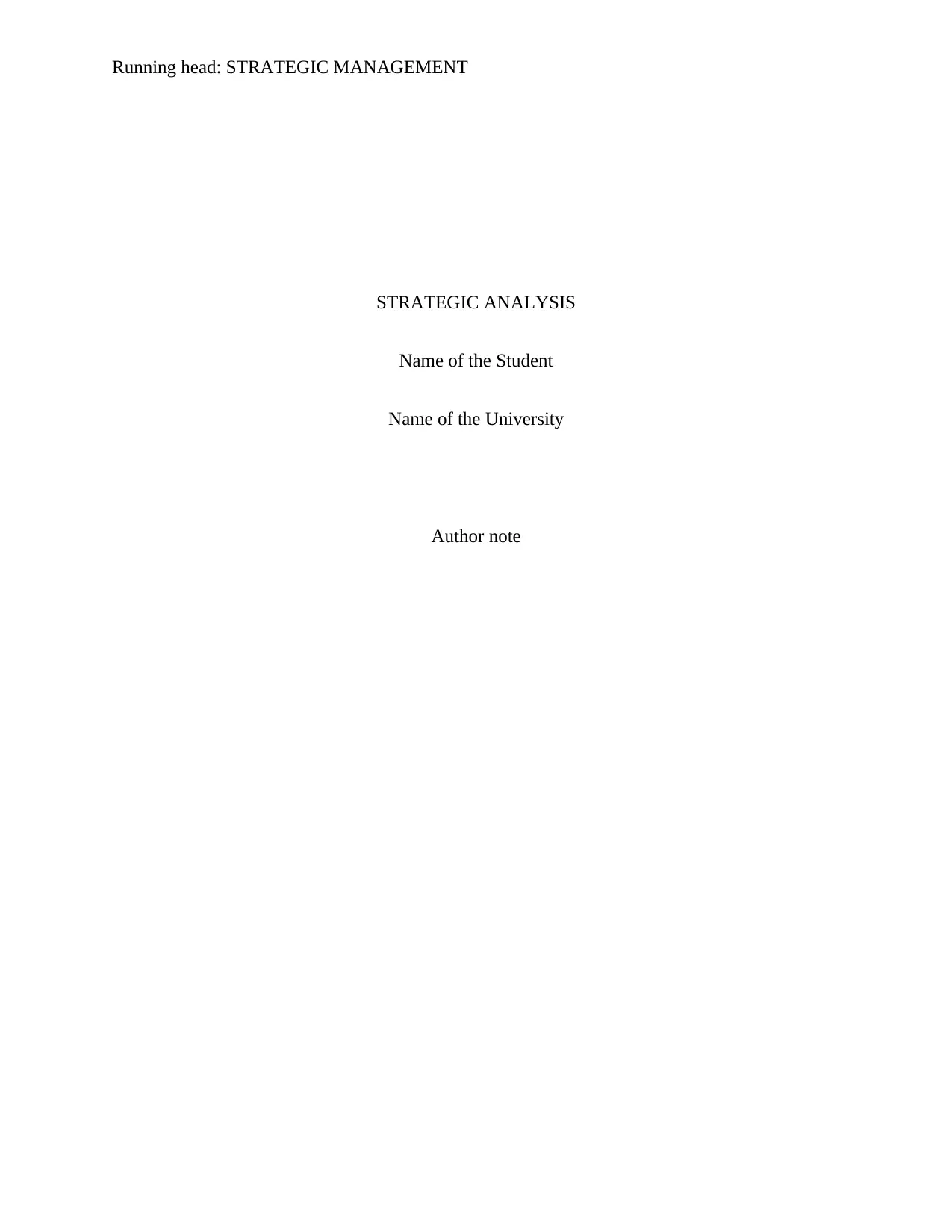
Running head: STRATEGIC MANAGEMENT
STRATEGIC ANALYSIS
Name of the Student
Name of the University
Author note
STRATEGIC ANALYSIS
Name of the Student
Name of the University
Author note
Secure Best Marks with AI Grader
Need help grading? Try our AI Grader for instant feedback on your assignments.
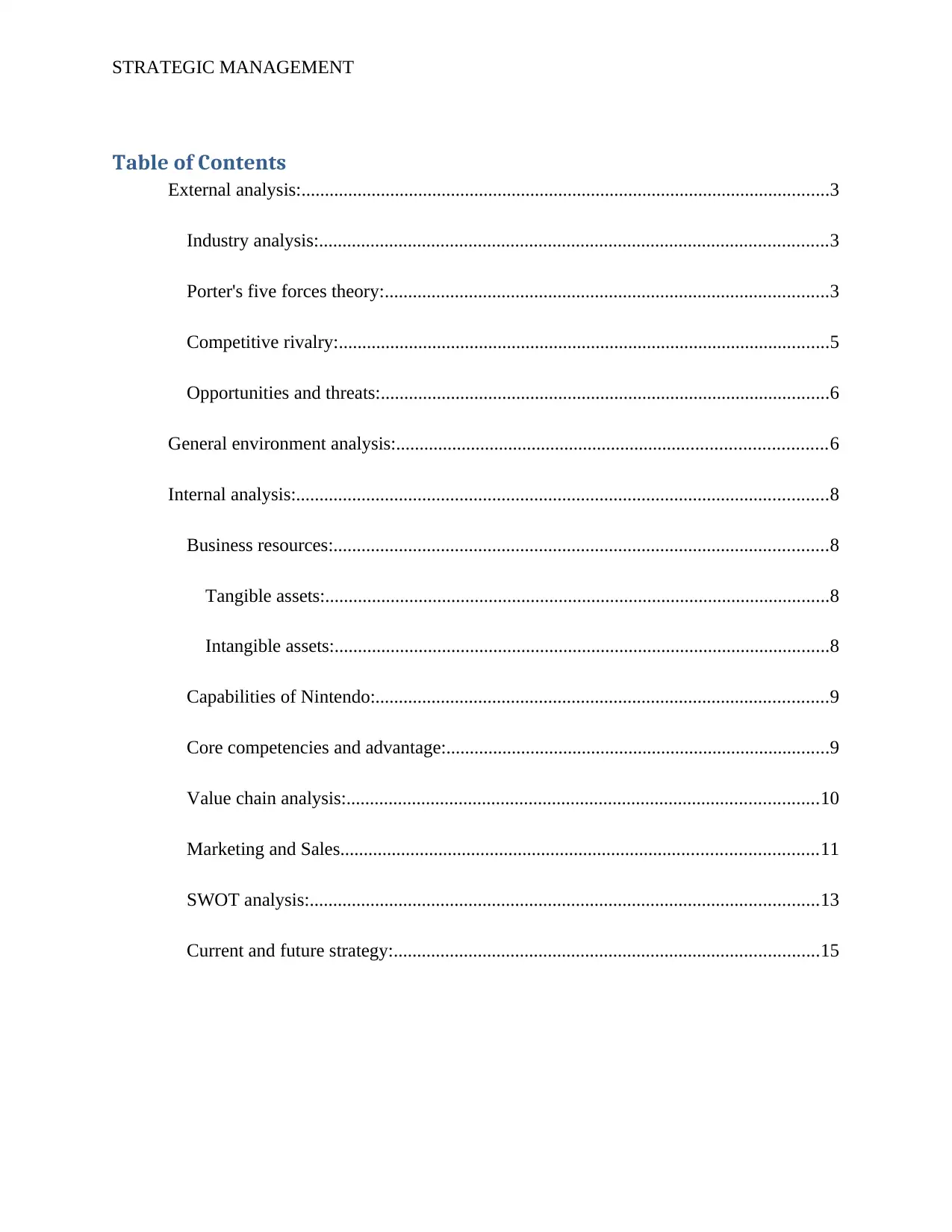
STRATEGIC MANAGEMENT
Table of Contents
External analysis:.................................................................................................................3
Industry analysis:.............................................................................................................3
Porter's five forces theory:...............................................................................................3
Competitive rivalry:.........................................................................................................5
Opportunities and threats:................................................................................................6
General environment analysis:............................................................................................6
Internal analysis:..................................................................................................................8
Business resources:..........................................................................................................8
Tangible assets:............................................................................................................8
Intangible assets:..........................................................................................................8
Capabilities of Nintendo:.................................................................................................9
Core competencies and advantage:..................................................................................9
Value chain analysis:.....................................................................................................10
Marketing and Sales......................................................................................................11
SWOT analysis:.............................................................................................................13
Current and future strategy:...........................................................................................15
Table of Contents
External analysis:.................................................................................................................3
Industry analysis:.............................................................................................................3
Porter's five forces theory:...............................................................................................3
Competitive rivalry:.........................................................................................................5
Opportunities and threats:................................................................................................6
General environment analysis:............................................................................................6
Internal analysis:..................................................................................................................8
Business resources:..........................................................................................................8
Tangible assets:............................................................................................................8
Intangible assets:..........................................................................................................8
Capabilities of Nintendo:.................................................................................................9
Core competencies and advantage:..................................................................................9
Value chain analysis:.....................................................................................................10
Marketing and Sales......................................................................................................11
SWOT analysis:.............................................................................................................13
Current and future strategy:...........................................................................................15
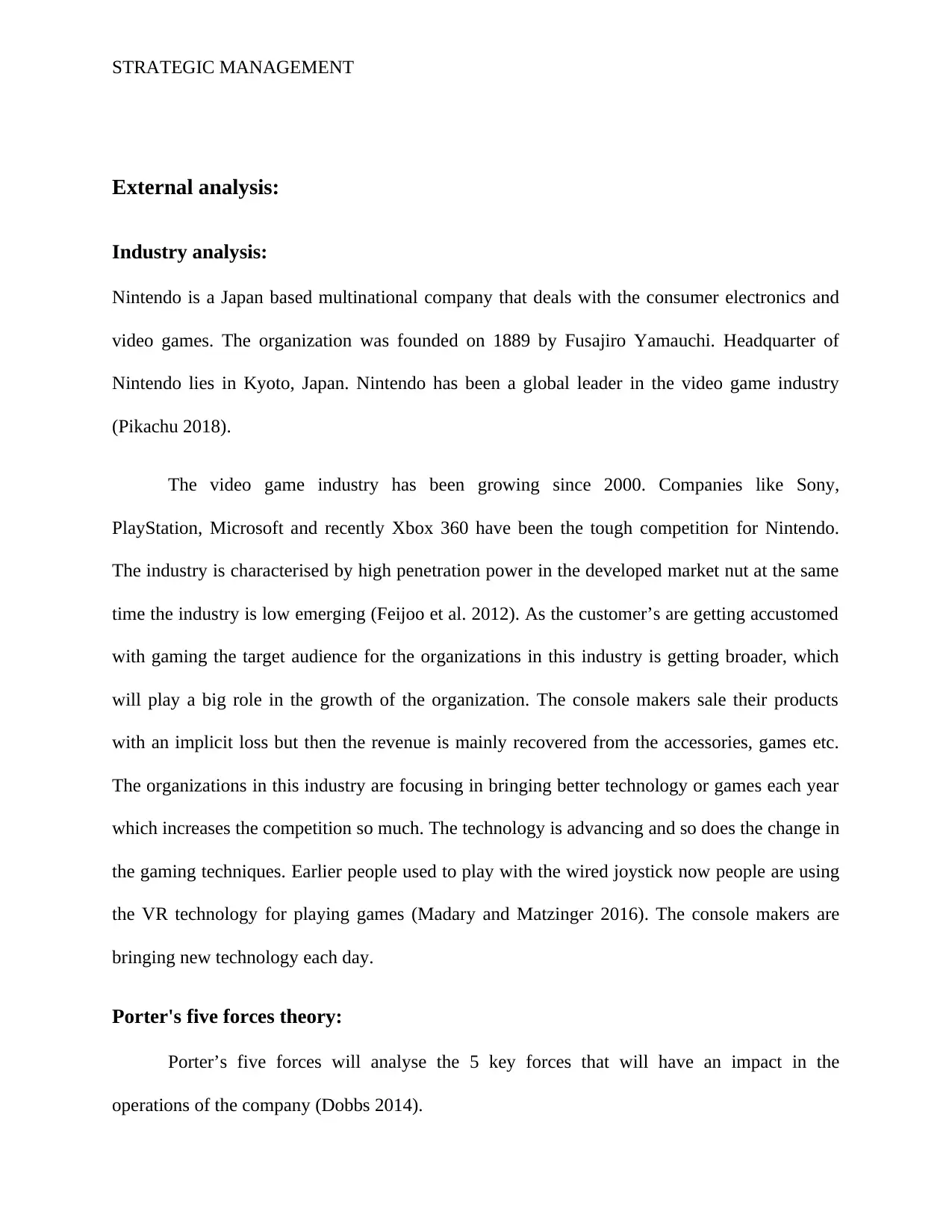
STRATEGIC MANAGEMENT
External analysis:
Industry analysis:
Nintendo is a Japan based multinational company that deals with the consumer electronics and
video games. The organization was founded on 1889 by Fusajiro Yamauchi. Headquarter of
Nintendo lies in Kyoto, Japan. Nintendo has been a global leader in the video game industry
(Pikachu 2018).
The video game industry has been growing since 2000. Companies like Sony,
PlayStation, Microsoft and recently Xbox 360 have been the tough competition for Nintendo.
The industry is characterised by high penetration power in the developed market nut at the same
time the industry is low emerging (Feijoo et al. 2012). As the customer’s are getting accustomed
with gaming the target audience for the organizations in this industry is getting broader, which
will play a big role in the growth of the organization. The console makers sale their products
with an implicit loss but then the revenue is mainly recovered from the accessories, games etc.
The organizations in this industry are focusing in bringing better technology or games each year
which increases the competition so much. The technology is advancing and so does the change in
the gaming techniques. Earlier people used to play with the wired joystick now people are using
the VR technology for playing games (Madary and Matzinger 2016). The console makers are
bringing new technology each day.
Porter's five forces theory:
Porter’s five forces will analyse the 5 key forces that will have an impact in the
operations of the company (Dobbs 2014).
External analysis:
Industry analysis:
Nintendo is a Japan based multinational company that deals with the consumer electronics and
video games. The organization was founded on 1889 by Fusajiro Yamauchi. Headquarter of
Nintendo lies in Kyoto, Japan. Nintendo has been a global leader in the video game industry
(Pikachu 2018).
The video game industry has been growing since 2000. Companies like Sony,
PlayStation, Microsoft and recently Xbox 360 have been the tough competition for Nintendo.
The industry is characterised by high penetration power in the developed market nut at the same
time the industry is low emerging (Feijoo et al. 2012). As the customer’s are getting accustomed
with gaming the target audience for the organizations in this industry is getting broader, which
will play a big role in the growth of the organization. The console makers sale their products
with an implicit loss but then the revenue is mainly recovered from the accessories, games etc.
The organizations in this industry are focusing in bringing better technology or games each year
which increases the competition so much. The technology is advancing and so does the change in
the gaming techniques. Earlier people used to play with the wired joystick now people are using
the VR technology for playing games (Madary and Matzinger 2016). The console makers are
bringing new technology each day.
Porter's five forces theory:
Porter’s five forces will analyse the 5 key forces that will have an impact in the
operations of the company (Dobbs 2014).
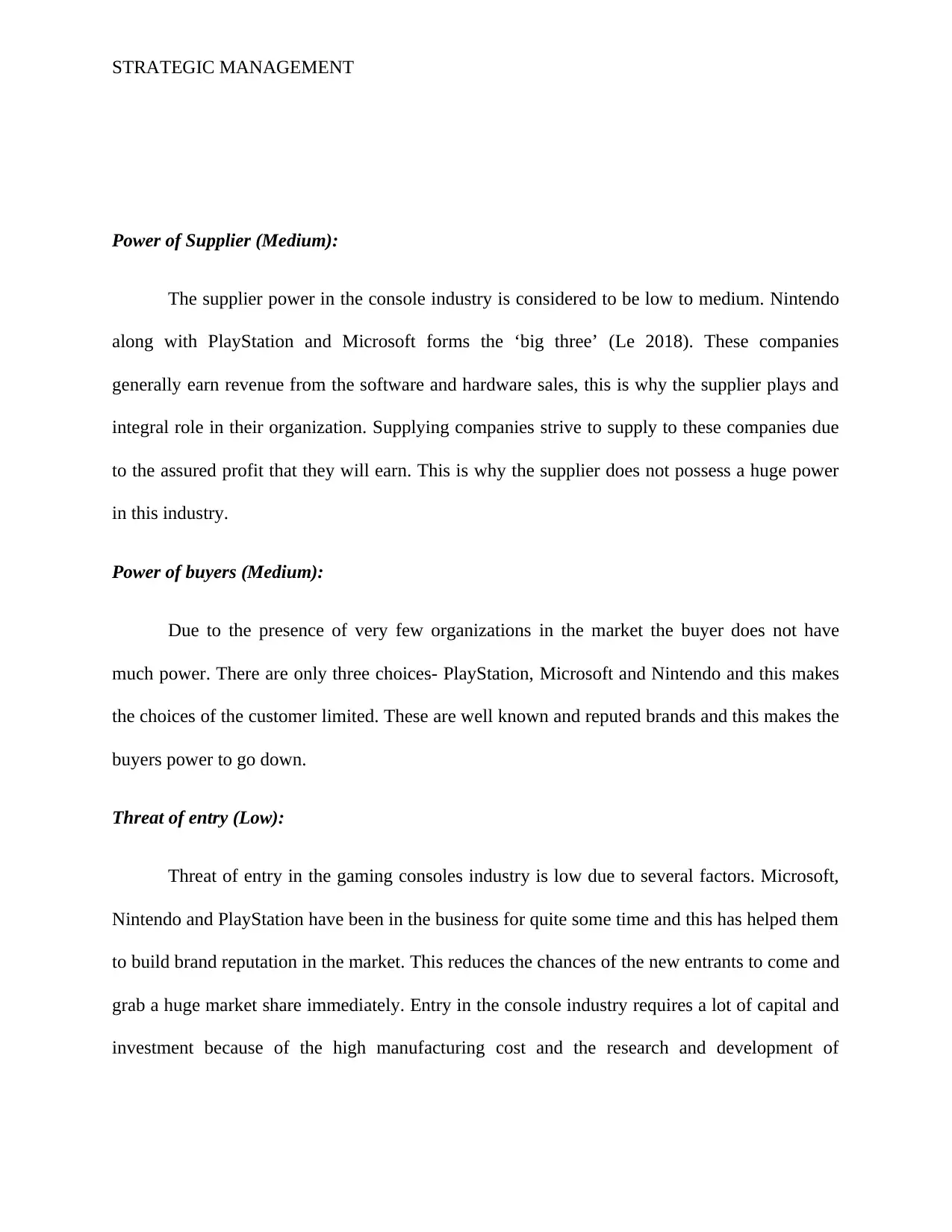
STRATEGIC MANAGEMENT
Power of Supplier (Medium):
The supplier power in the console industry is considered to be low to medium. Nintendo
along with PlayStation and Microsoft forms the ‘big three’ (Le 2018). These companies
generally earn revenue from the software and hardware sales, this is why the supplier plays and
integral role in their organization. Supplying companies strive to supply to these companies due
to the assured profit that they will earn. This is why the supplier does not possess a huge power
in this industry.
Power of buyers (Medium):
Due to the presence of very few organizations in the market the buyer does not have
much power. There are only three choices- PlayStation, Microsoft and Nintendo and this makes
the choices of the customer limited. These are well known and reputed brands and this makes the
buyers power to go down.
Threat of entry (Low):
Threat of entry in the gaming consoles industry is low due to several factors. Microsoft,
Nintendo and PlayStation have been in the business for quite some time and this has helped them
to build brand reputation in the market. This reduces the chances of the new entrants to come and
grab a huge market share immediately. Entry in the console industry requires a lot of capital and
investment because of the high manufacturing cost and the research and development of
Power of Supplier (Medium):
The supplier power in the console industry is considered to be low to medium. Nintendo
along with PlayStation and Microsoft forms the ‘big three’ (Le 2018). These companies
generally earn revenue from the software and hardware sales, this is why the supplier plays and
integral role in their organization. Supplying companies strive to supply to these companies due
to the assured profit that they will earn. This is why the supplier does not possess a huge power
in this industry.
Power of buyers (Medium):
Due to the presence of very few organizations in the market the buyer does not have
much power. There are only three choices- PlayStation, Microsoft and Nintendo and this makes
the choices of the customer limited. These are well known and reputed brands and this makes the
buyers power to go down.
Threat of entry (Low):
Threat of entry in the gaming consoles industry is low due to several factors. Microsoft,
Nintendo and PlayStation have been in the business for quite some time and this has helped them
to build brand reputation in the market. This reduces the chances of the new entrants to come and
grab a huge market share immediately. Entry in the console industry requires a lot of capital and
investment because of the high manufacturing cost and the research and development of
Secure Best Marks with AI Grader
Need help grading? Try our AI Grader for instant feedback on your assignments.

STRATEGIC MANAGEMENT
advanced technologies, marketing and advertising which makes the entry of the new entrants
tough Carnabuci, Operti and Kovacs 2015).
Threat of substitutes (Medium):
Games can be either developed internally or by the third party developers. This is why
companies like Nintendo and Microsoft the leading development studios in order to manufacture
exclusive games. There are other substitutes for entertainment for the consumer like movies, TV
series etc. The biggest substitutes are the mobile gaming and the PC games (Rogers and Clarkson
2017).
Threat of rivalries (High):
Due to the presence of few competitors the industry is growing rapidly and constantly,
which makes the gaming console industry very competitive. Nintendo, Microsoft and Sony are
continuously trying to outsell each other and increase the company’s market share. These
companies also compete for the same consumers and the same customers, which makes the
threat of rivalry high.
Competitive rivalry:
The gaming console sector does not have many competitors. The top three rival
companies are Microsoft, Nintendo and Sony. The Xbox one, Xbox 360 is some of the key
products of Microsoft that helped the organization to create their own market share. Similarly
PlayStation 1, 2 and 3 are some of the key products of Sony.
advanced technologies, marketing and advertising which makes the entry of the new entrants
tough Carnabuci, Operti and Kovacs 2015).
Threat of substitutes (Medium):
Games can be either developed internally or by the third party developers. This is why
companies like Nintendo and Microsoft the leading development studios in order to manufacture
exclusive games. There are other substitutes for entertainment for the consumer like movies, TV
series etc. The biggest substitutes are the mobile gaming and the PC games (Rogers and Clarkson
2017).
Threat of rivalries (High):
Due to the presence of few competitors the industry is growing rapidly and constantly,
which makes the gaming console industry very competitive. Nintendo, Microsoft and Sony are
continuously trying to outsell each other and increase the company’s market share. These
companies also compete for the same consumers and the same customers, which makes the
threat of rivalry high.
Competitive rivalry:
The gaming console sector does not have many competitors. The top three rival
companies are Microsoft, Nintendo and Sony. The Xbox one, Xbox 360 is some of the key
products of Microsoft that helped the organization to create their own market share. Similarly
PlayStation 1, 2 and 3 are some of the key products of Sony.
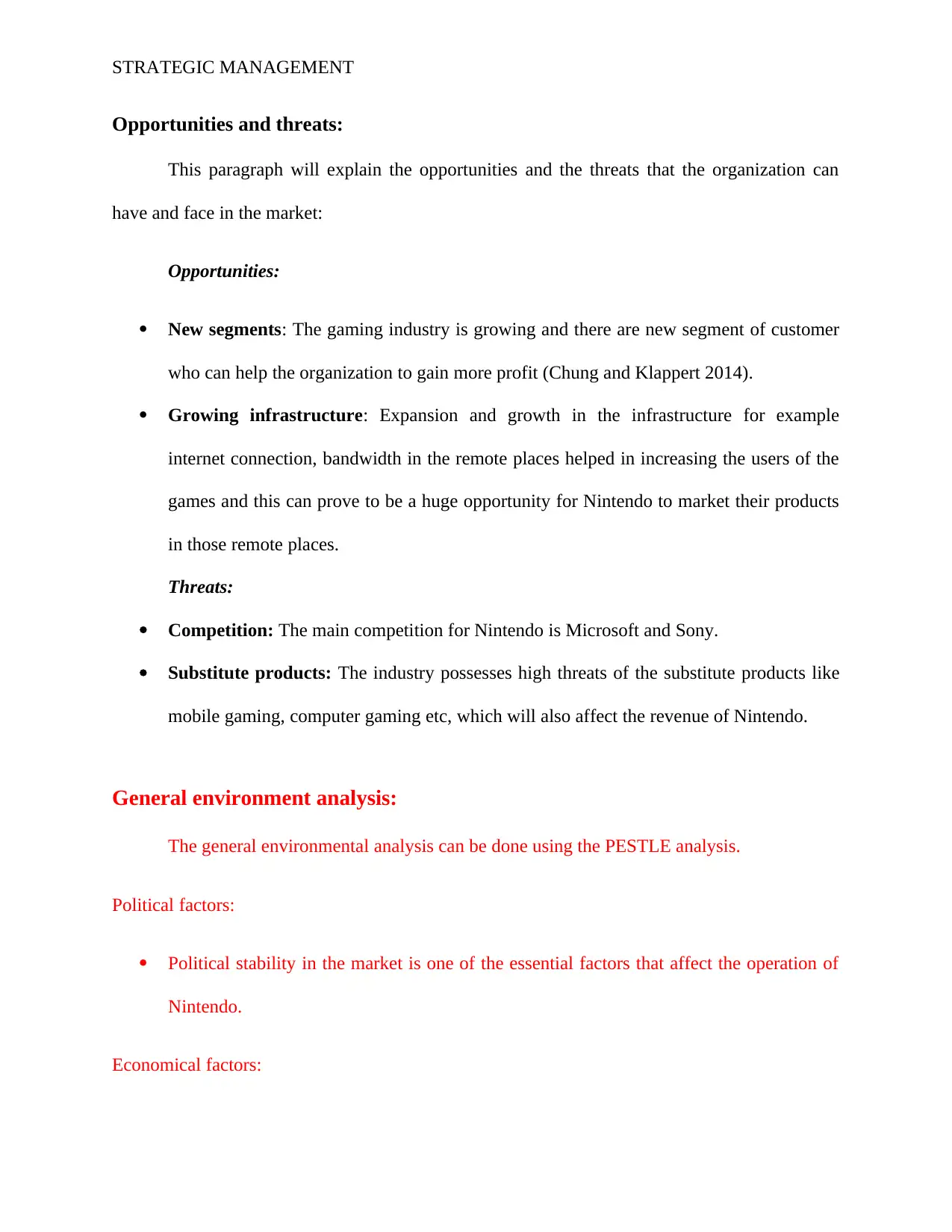
STRATEGIC MANAGEMENT
Opportunities and threats:
This paragraph will explain the opportunities and the threats that the organization can
have and face in the market:
Opportunities:
New segments: The gaming industry is growing and there are new segment of customer
who can help the organization to gain more profit (Chung and Klappert 2014).
Growing infrastructure: Expansion and growth in the infrastructure for example
internet connection, bandwidth in the remote places helped in increasing the users of the
games and this can prove to be a huge opportunity for Nintendo to market their products
in those remote places.
Threats:
Competition: The main competition for Nintendo is Microsoft and Sony.
Substitute products: The industry possesses high threats of the substitute products like
mobile gaming, computer gaming etc, which will also affect the revenue of Nintendo.
General environment analysis:
The general environmental analysis can be done using the PESTLE analysis.
Political factors:
Political stability in the market is one of the essential factors that affect the operation of
Nintendo.
Economical factors:
Opportunities and threats:
This paragraph will explain the opportunities and the threats that the organization can
have and face in the market:
Opportunities:
New segments: The gaming industry is growing and there are new segment of customer
who can help the organization to gain more profit (Chung and Klappert 2014).
Growing infrastructure: Expansion and growth in the infrastructure for example
internet connection, bandwidth in the remote places helped in increasing the users of the
games and this can prove to be a huge opportunity for Nintendo to market their products
in those remote places.
Threats:
Competition: The main competition for Nintendo is Microsoft and Sony.
Substitute products: The industry possesses high threats of the substitute products like
mobile gaming, computer gaming etc, which will also affect the revenue of Nintendo.
General environment analysis:
The general environmental analysis can be done using the PESTLE analysis.
Political factors:
Political stability in the market is one of the essential factors that affect the operation of
Nintendo.
Economical factors:
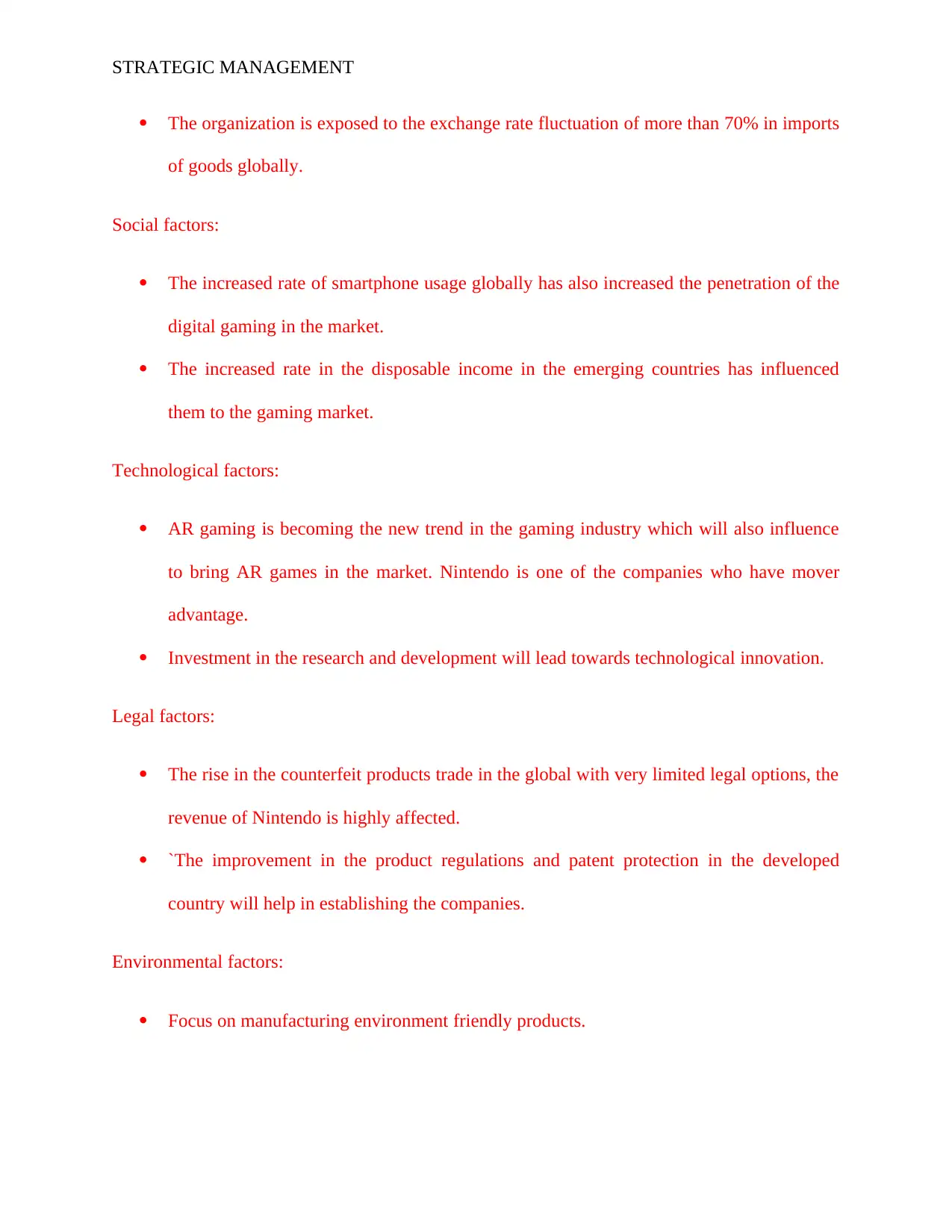
STRATEGIC MANAGEMENT
The organization is exposed to the exchange rate fluctuation of more than 70% in imports
of goods globally.
Social factors:
The increased rate of smartphone usage globally has also increased the penetration of the
digital gaming in the market.
The increased rate in the disposable income in the emerging countries has influenced
them to the gaming market.
Technological factors:
AR gaming is becoming the new trend in the gaming industry which will also influence
to bring AR games in the market. Nintendo is one of the companies who have mover
advantage.
Investment in the research and development will lead towards technological innovation.
Legal factors:
The rise in the counterfeit products trade in the global with very limited legal options, the
revenue of Nintendo is highly affected.
`The improvement in the product regulations and patent protection in the developed
country will help in establishing the companies.
Environmental factors:
Focus on manufacturing environment friendly products.
The organization is exposed to the exchange rate fluctuation of more than 70% in imports
of goods globally.
Social factors:
The increased rate of smartphone usage globally has also increased the penetration of the
digital gaming in the market.
The increased rate in the disposable income in the emerging countries has influenced
them to the gaming market.
Technological factors:
AR gaming is becoming the new trend in the gaming industry which will also influence
to bring AR games in the market. Nintendo is one of the companies who have mover
advantage.
Investment in the research and development will lead towards technological innovation.
Legal factors:
The rise in the counterfeit products trade in the global with very limited legal options, the
revenue of Nintendo is highly affected.
`The improvement in the product regulations and patent protection in the developed
country will help in establishing the companies.
Environmental factors:
Focus on manufacturing environment friendly products.
Paraphrase This Document
Need a fresh take? Get an instant paraphrase of this document with our AI Paraphraser
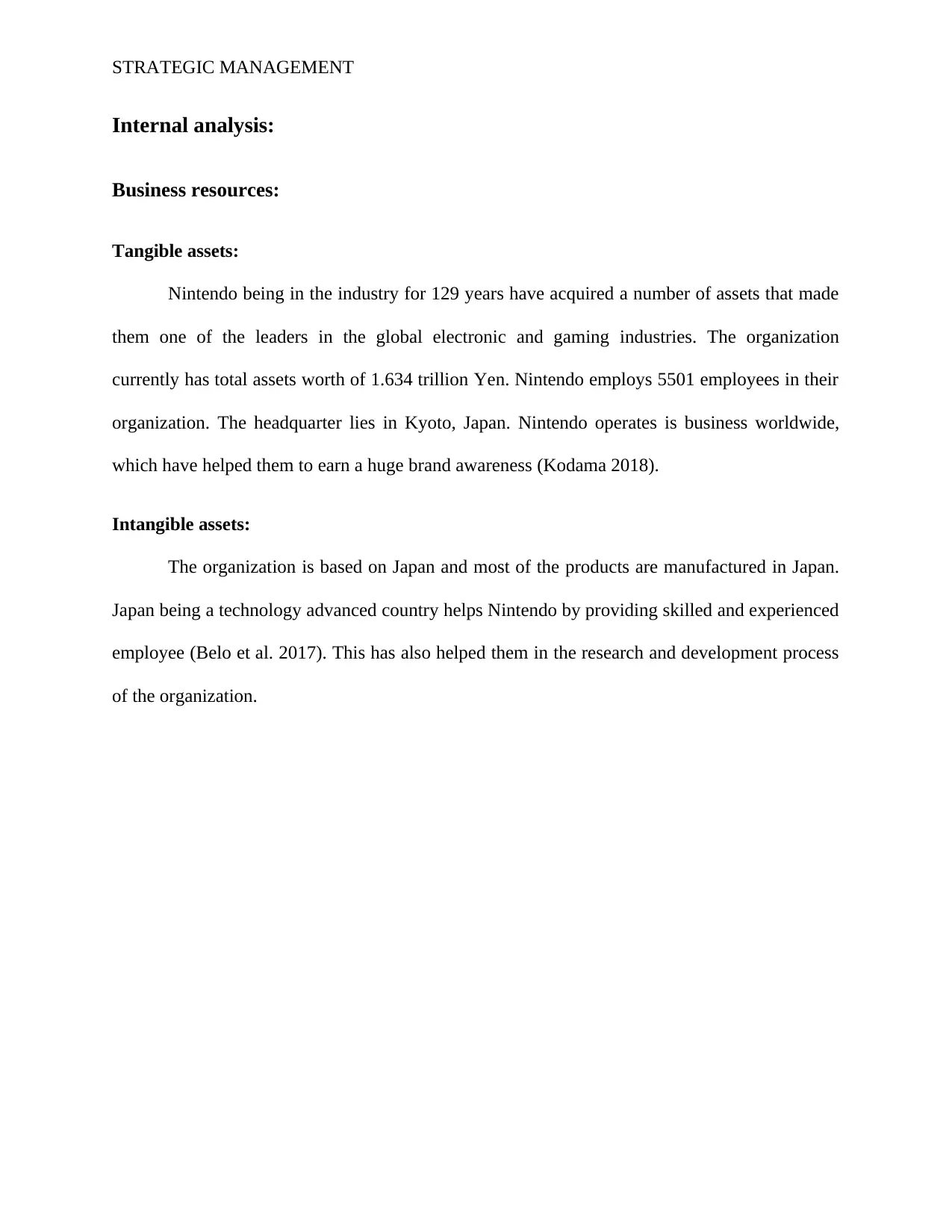
STRATEGIC MANAGEMENT
Internal analysis:
Business resources:
Tangible assets:
Nintendo being in the industry for 129 years have acquired a number of assets that made
them one of the leaders in the global electronic and gaming industries. The organization
currently has total assets worth of 1.634 trillion Yen. Nintendo employs 5501 employees in their
organization. The headquarter lies in Kyoto, Japan. Nintendo operates is business worldwide,
which have helped them to earn a huge brand awareness (Kodama 2018).
Intangible assets:
The organization is based on Japan and most of the products are manufactured in Japan.
Japan being a technology advanced country helps Nintendo by providing skilled and experienced
employee (Belo et al. 2017). This has also helped them in the research and development process
of the organization.
Internal analysis:
Business resources:
Tangible assets:
Nintendo being in the industry for 129 years have acquired a number of assets that made
them one of the leaders in the global electronic and gaming industries. The organization
currently has total assets worth of 1.634 trillion Yen. Nintendo employs 5501 employees in their
organization. The headquarter lies in Kyoto, Japan. Nintendo operates is business worldwide,
which have helped them to earn a huge brand awareness (Kodama 2018).
Intangible assets:
The organization is based on Japan and most of the products are manufactured in Japan.
Japan being a technology advanced country helps Nintendo by providing skilled and experienced
employee (Belo et al. 2017). This has also helped them in the research and development process
of the organization.
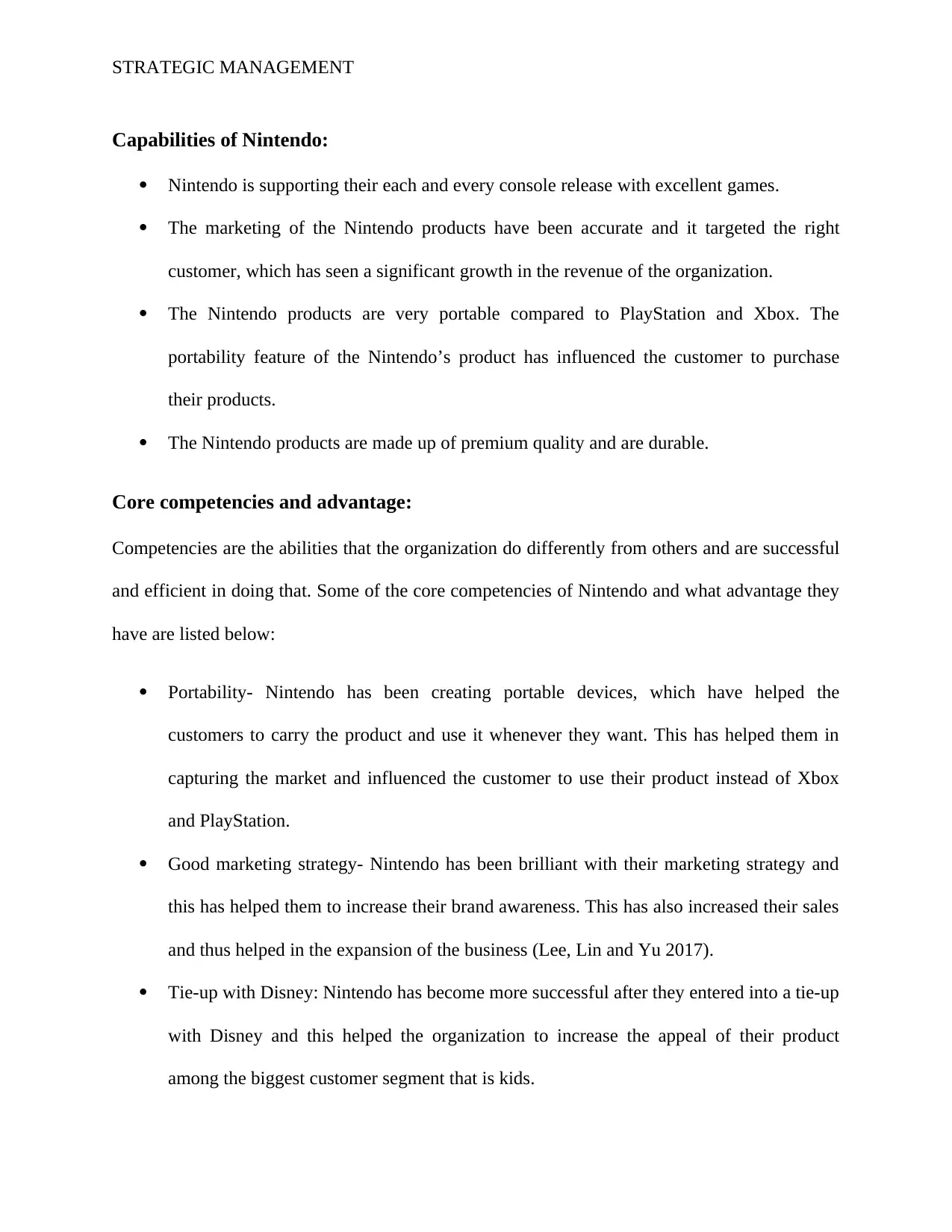
STRATEGIC MANAGEMENT
Capabilities of Nintendo:
Nintendo is supporting their each and every console release with excellent games.
The marketing of the Nintendo products have been accurate and it targeted the right
customer, which has seen a significant growth in the revenue of the organization.
The Nintendo products are very portable compared to PlayStation and Xbox. The
portability feature of the Nintendo’s product has influenced the customer to purchase
their products.
The Nintendo products are made up of premium quality and are durable.
Core competencies and advantage:
Competencies are the abilities that the organization do differently from others and are successful
and efficient in doing that. Some of the core competencies of Nintendo and what advantage they
have are listed below:
Portability- Nintendo has been creating portable devices, which have helped the
customers to carry the product and use it whenever they want. This has helped them in
capturing the market and influenced the customer to use their product instead of Xbox
and PlayStation.
Good marketing strategy- Nintendo has been brilliant with their marketing strategy and
this has helped them to increase their brand awareness. This has also increased their sales
and thus helped in the expansion of the business (Lee, Lin and Yu 2017).
Tie-up with Disney: Nintendo has become more successful after they entered into a tie-up
with Disney and this helped the organization to increase the appeal of their product
among the biggest customer segment that is kids.
Capabilities of Nintendo:
Nintendo is supporting their each and every console release with excellent games.
The marketing of the Nintendo products have been accurate and it targeted the right
customer, which has seen a significant growth in the revenue of the organization.
The Nintendo products are very portable compared to PlayStation and Xbox. The
portability feature of the Nintendo’s product has influenced the customer to purchase
their products.
The Nintendo products are made up of premium quality and are durable.
Core competencies and advantage:
Competencies are the abilities that the organization do differently from others and are successful
and efficient in doing that. Some of the core competencies of Nintendo and what advantage they
have are listed below:
Portability- Nintendo has been creating portable devices, which have helped the
customers to carry the product and use it whenever they want. This has helped them in
capturing the market and influenced the customer to use their product instead of Xbox
and PlayStation.
Good marketing strategy- Nintendo has been brilliant with their marketing strategy and
this has helped them to increase their brand awareness. This has also increased their sales
and thus helped in the expansion of the business (Lee, Lin and Yu 2017).
Tie-up with Disney: Nintendo has become more successful after they entered into a tie-up
with Disney and this helped the organization to increase the appeal of their product
among the biggest customer segment that is kids.

STRATEGIC MANAGEMENT
Value chain analysis:
Value chain analysis:
Secure Best Marks with AI Grader
Need help grading? Try our AI Grader for instant feedback on your assignments.
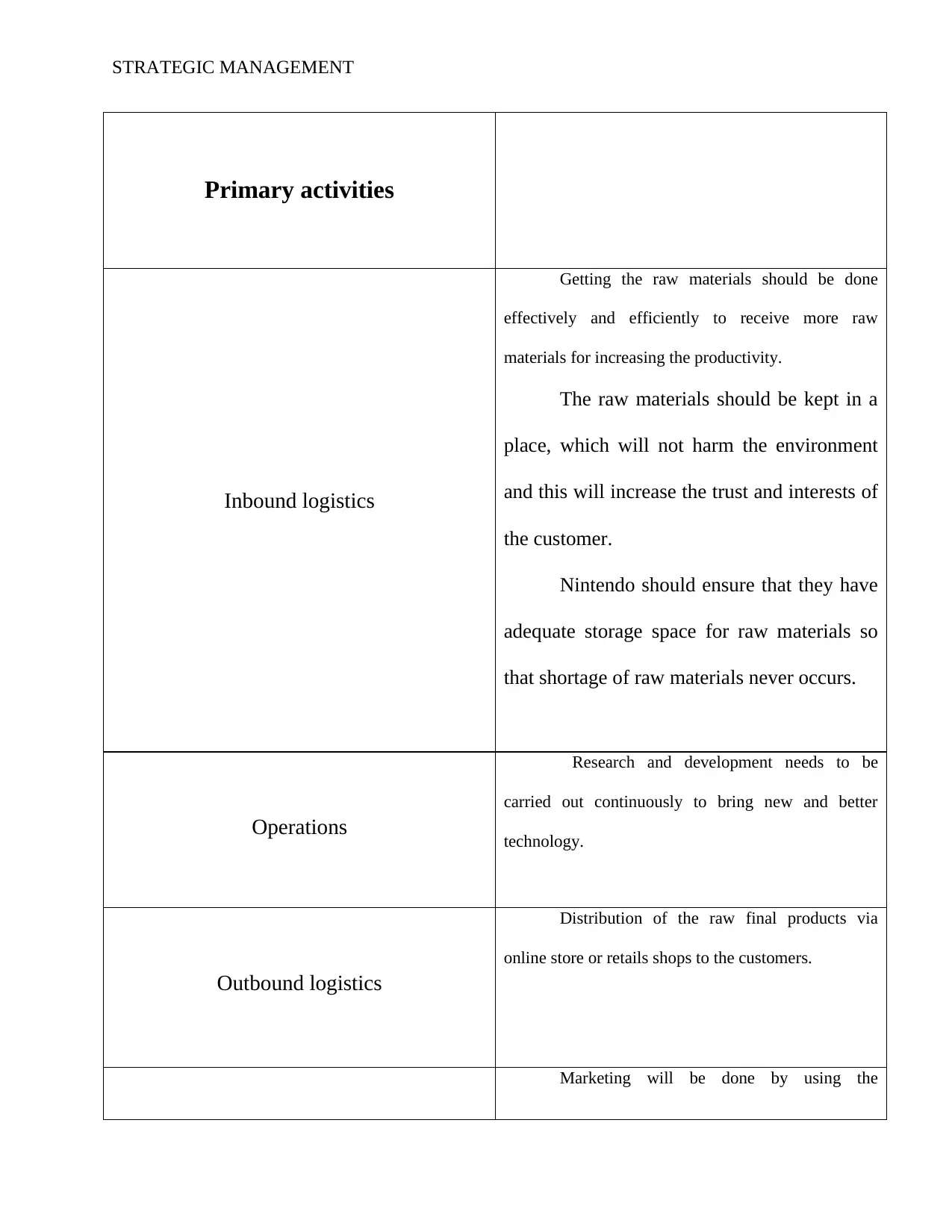
STRATEGIC MANAGEMENT
Primary activities
Inbound logistics
Getting the raw materials should be done
effectively and efficiently to receive more raw
materials for increasing the productivity.
The raw materials should be kept in a
place, which will not harm the environment
and this will increase the trust and interests of
the customer.
Nintendo should ensure that they have
adequate storage space for raw materials so
that shortage of raw materials never occurs.
Operations
Research and development needs to be
carried out continuously to bring new and better
technology.
Outbound logistics
Distribution of the raw final products via
online store or retails shops to the customers.
Marketing will be done by using the
Primary activities
Inbound logistics
Getting the raw materials should be done
effectively and efficiently to receive more raw
materials for increasing the productivity.
The raw materials should be kept in a
place, which will not harm the environment
and this will increase the trust and interests of
the customer.
Nintendo should ensure that they have
adequate storage space for raw materials so
that shortage of raw materials never occurs.
Operations
Research and development needs to be
carried out continuously to bring new and better
technology.
Outbound logistics
Distribution of the raw final products via
online store or retails shops to the customers.
Marketing will be done by using the
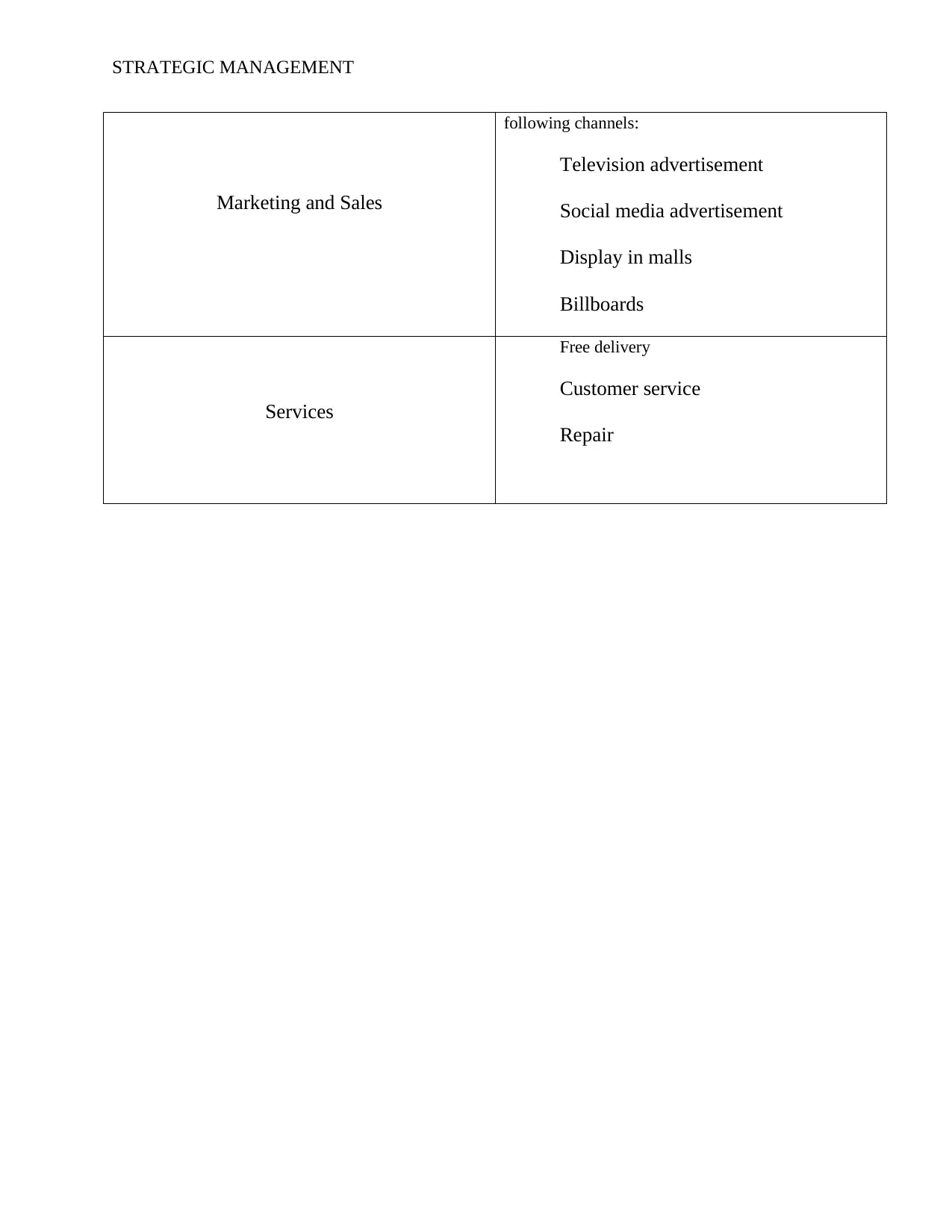
STRATEGIC MANAGEMENT
Marketing and Sales
following channels:
Television advertisement
Social media advertisement
Display in malls
Billboards
Services
Free delivery
Customer service
Repair
Marketing and Sales
following channels:
Television advertisement
Social media advertisement
Display in malls
Billboards
Services
Free delivery
Customer service
Repair
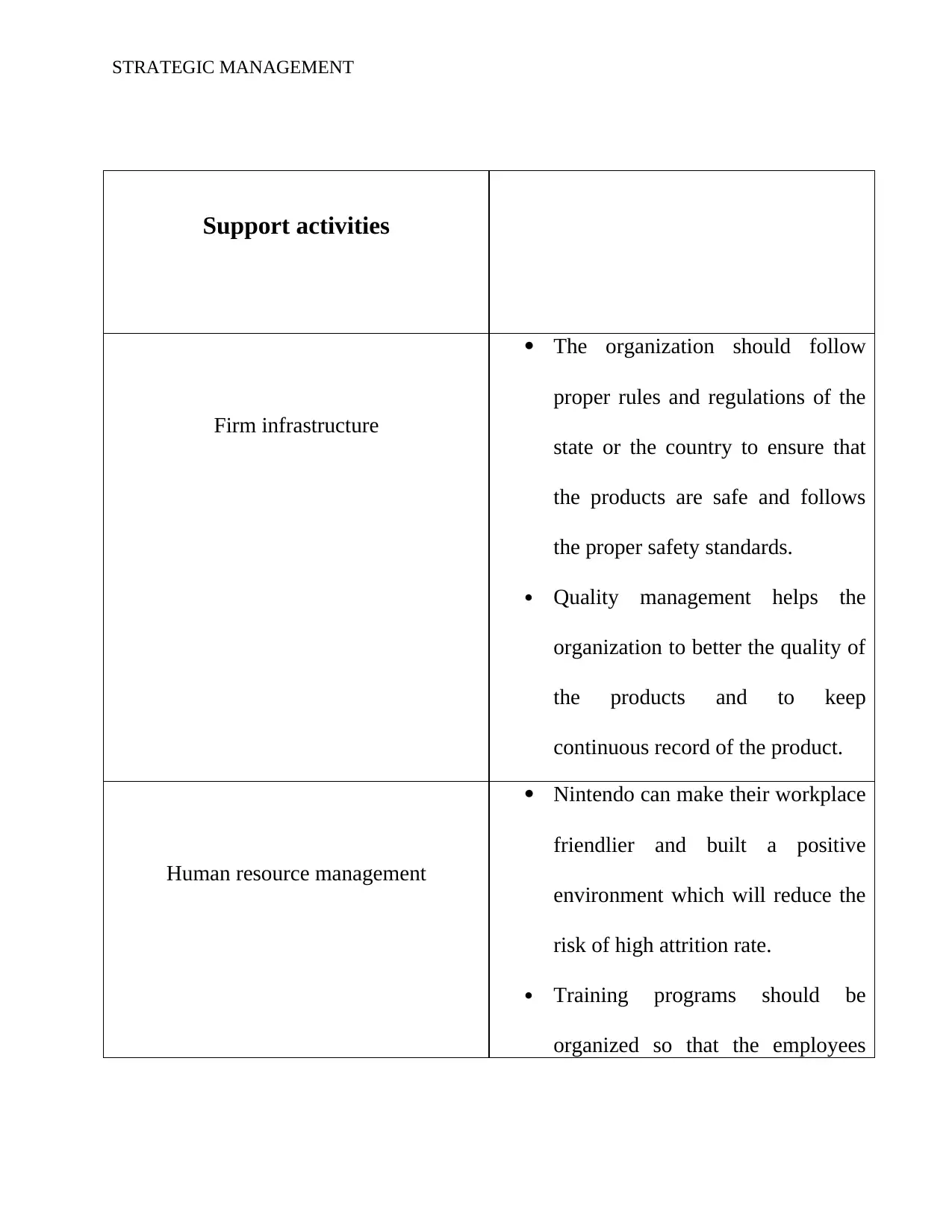
STRATEGIC MANAGEMENT
Support activities
Firm infrastructure
The organization should follow
proper rules and regulations of the
state or the country to ensure that
the products are safe and follows
the proper safety standards.
Quality management helps the
organization to better the quality of
the products and to keep
continuous record of the product.
Human resource management
Nintendo can make their workplace
friendlier and built a positive
environment which will reduce the
risk of high attrition rate.
Training programs should be
organized so that the employees
Support activities
Firm infrastructure
The organization should follow
proper rules and regulations of the
state or the country to ensure that
the products are safe and follows
the proper safety standards.
Quality management helps the
organization to better the quality of
the products and to keep
continuous record of the product.
Human resource management
Nintendo can make their workplace
friendlier and built a positive
environment which will reduce the
risk of high attrition rate.
Training programs should be
organized so that the employees
Paraphrase This Document
Need a fresh take? Get an instant paraphrase of this document with our AI Paraphraser
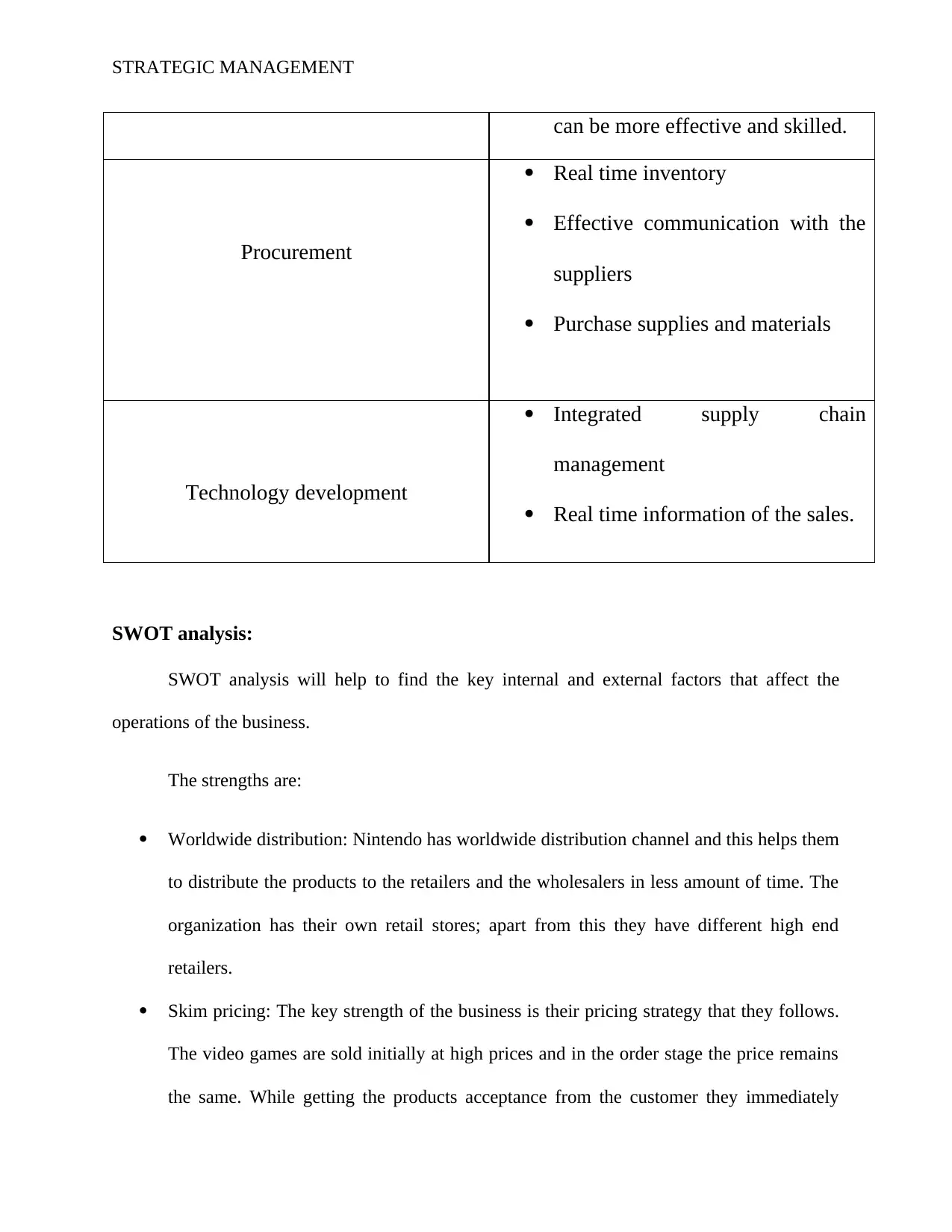
STRATEGIC MANAGEMENT
can be more effective and skilled.
Procurement
Real time inventory
Effective communication with the
suppliers
Purchase supplies and materials
Technology development
Integrated supply chain
management
Real time information of the sales.
SWOT analysis:
SWOT analysis will help to find the key internal and external factors that affect the
operations of the business.
The strengths are:
Worldwide distribution: Nintendo has worldwide distribution channel and this helps them
to distribute the products to the retailers and the wholesalers in less amount of time. The
organization has their own retail stores; apart from this they have different high end
retailers.
Skim pricing: The key strength of the business is their pricing strategy that they follows.
The video games are sold initially at high prices and in the order stage the price remains
the same. While getting the products acceptance from the customer they immediately
can be more effective and skilled.
Procurement
Real time inventory
Effective communication with the
suppliers
Purchase supplies and materials
Technology development
Integrated supply chain
management
Real time information of the sales.
SWOT analysis:
SWOT analysis will help to find the key internal and external factors that affect the
operations of the business.
The strengths are:
Worldwide distribution: Nintendo has worldwide distribution channel and this helps them
to distribute the products to the retailers and the wholesalers in less amount of time. The
organization has their own retail stores; apart from this they have different high end
retailers.
Skim pricing: The key strength of the business is their pricing strategy that they follows.
The video games are sold initially at high prices and in the order stage the price remains
the same. While getting the products acceptance from the customer they immediately
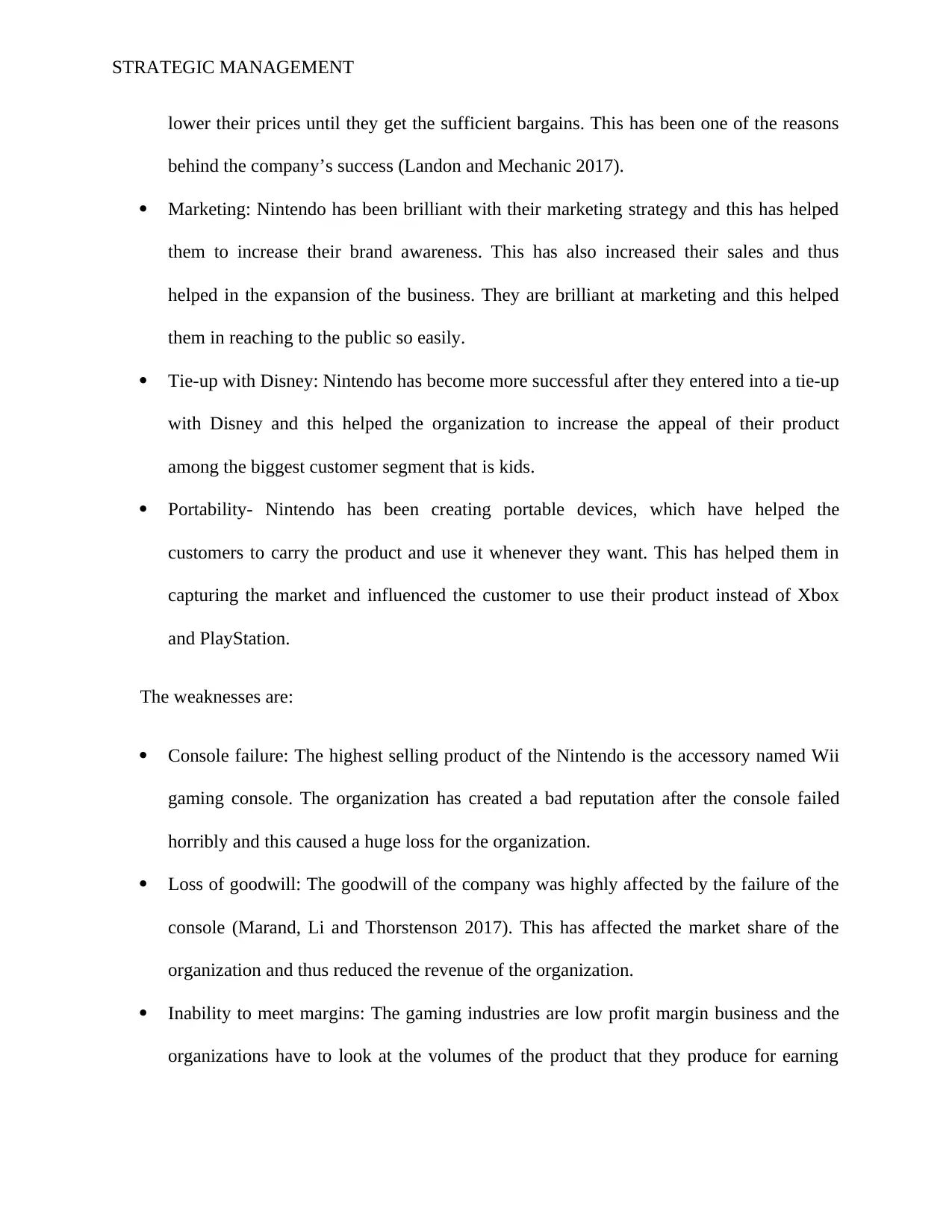
STRATEGIC MANAGEMENT
lower their prices until they get the sufficient bargains. This has been one of the reasons
behind the company’s success (Landon and Mechanic 2017).
Marketing: Nintendo has been brilliant with their marketing strategy and this has helped
them to increase their brand awareness. This has also increased their sales and thus
helped in the expansion of the business. They are brilliant at marketing and this helped
them in reaching to the public so easily.
Tie-up with Disney: Nintendo has become more successful after they entered into a tie-up
with Disney and this helped the organization to increase the appeal of their product
among the biggest customer segment that is kids.
Portability- Nintendo has been creating portable devices, which have helped the
customers to carry the product and use it whenever they want. This has helped them in
capturing the market and influenced the customer to use their product instead of Xbox
and PlayStation.
The weaknesses are:
Console failure: The highest selling product of the Nintendo is the accessory named Wii
gaming console. The organization has created a bad reputation after the console failed
horribly and this caused a huge loss for the organization.
Loss of goodwill: The goodwill of the company was highly affected by the failure of the
console (Marand, Li and Thorstenson 2017). This has affected the market share of the
organization and thus reduced the revenue of the organization.
Inability to meet margins: The gaming industries are low profit margin business and the
organizations have to look at the volumes of the product that they produce for earning
lower their prices until they get the sufficient bargains. This has been one of the reasons
behind the company’s success (Landon and Mechanic 2017).
Marketing: Nintendo has been brilliant with their marketing strategy and this has helped
them to increase their brand awareness. This has also increased their sales and thus
helped in the expansion of the business. They are brilliant at marketing and this helped
them in reaching to the public so easily.
Tie-up with Disney: Nintendo has become more successful after they entered into a tie-up
with Disney and this helped the organization to increase the appeal of their product
among the biggest customer segment that is kids.
Portability- Nintendo has been creating portable devices, which have helped the
customers to carry the product and use it whenever they want. This has helped them in
capturing the market and influenced the customer to use their product instead of Xbox
and PlayStation.
The weaknesses are:
Console failure: The highest selling product of the Nintendo is the accessory named Wii
gaming console. The organization has created a bad reputation after the console failed
horribly and this caused a huge loss for the organization.
Loss of goodwill: The goodwill of the company was highly affected by the failure of the
console (Marand, Li and Thorstenson 2017). This has affected the market share of the
organization and thus reduced the revenue of the organization.
Inability to meet margins: The gaming industries are low profit margin business and the
organizations have to look at the volumes of the product that they produce for earning
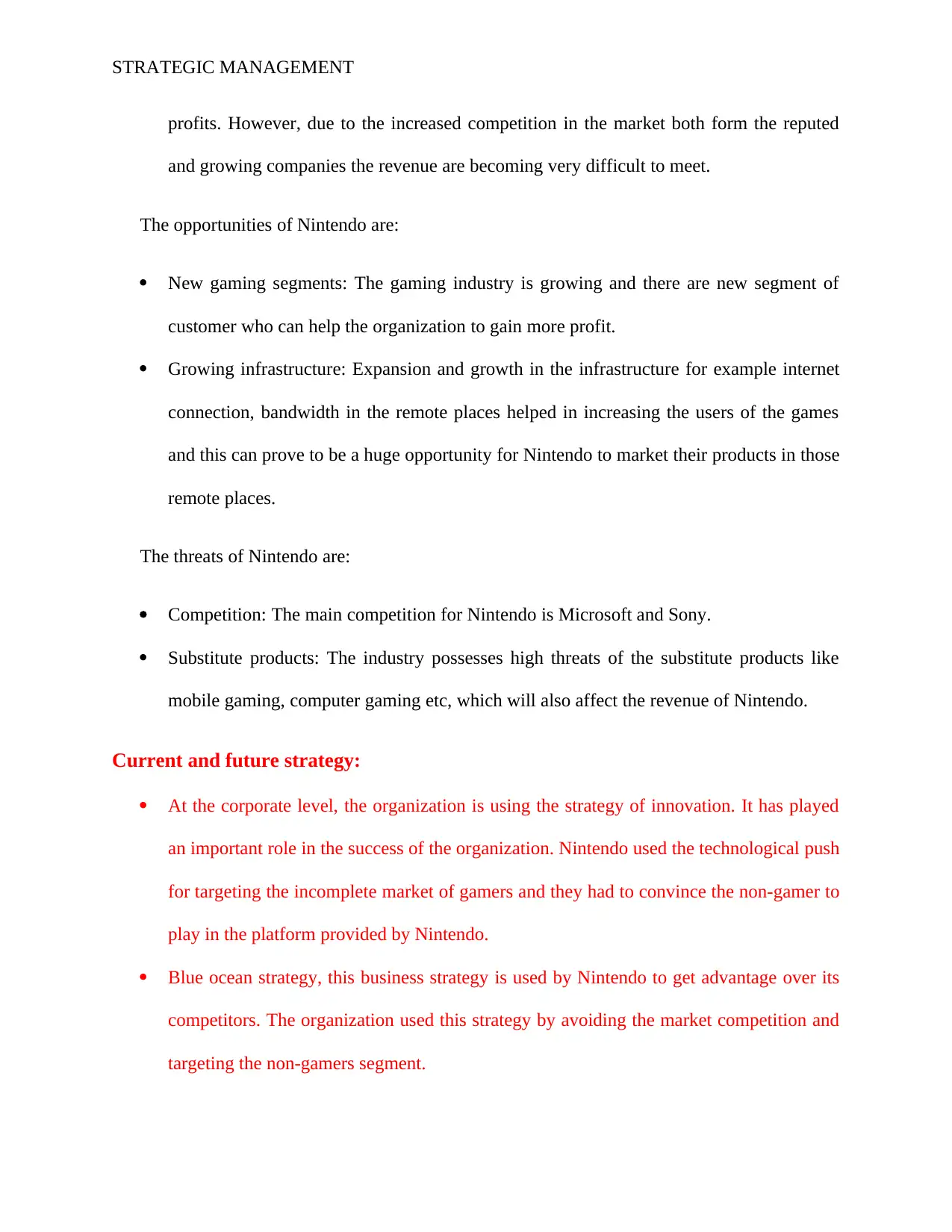
STRATEGIC MANAGEMENT
profits. However, due to the increased competition in the market both form the reputed
and growing companies the revenue are becoming very difficult to meet.
The opportunities of Nintendo are:
New gaming segments: The gaming industry is growing and there are new segment of
customer who can help the organization to gain more profit.
Growing infrastructure: Expansion and growth in the infrastructure for example internet
connection, bandwidth in the remote places helped in increasing the users of the games
and this can prove to be a huge opportunity for Nintendo to market their products in those
remote places.
The threats of Nintendo are:
Competition: The main competition for Nintendo is Microsoft and Sony.
Substitute products: The industry possesses high threats of the substitute products like
mobile gaming, computer gaming etc, which will also affect the revenue of Nintendo.
Current and future strategy:
At the corporate level, the organization is using the strategy of innovation. It has played
an important role in the success of the organization. Nintendo used the technological push
for targeting the incomplete market of gamers and they had to convince the non-gamer to
play in the platform provided by Nintendo.
Blue ocean strategy, this business strategy is used by Nintendo to get advantage over its
competitors. The organization used this strategy by avoiding the market competition and
targeting the non-gamers segment.
profits. However, due to the increased competition in the market both form the reputed
and growing companies the revenue are becoming very difficult to meet.
The opportunities of Nintendo are:
New gaming segments: The gaming industry is growing and there are new segment of
customer who can help the organization to gain more profit.
Growing infrastructure: Expansion and growth in the infrastructure for example internet
connection, bandwidth in the remote places helped in increasing the users of the games
and this can prove to be a huge opportunity for Nintendo to market their products in those
remote places.
The threats of Nintendo are:
Competition: The main competition for Nintendo is Microsoft and Sony.
Substitute products: The industry possesses high threats of the substitute products like
mobile gaming, computer gaming etc, which will also affect the revenue of Nintendo.
Current and future strategy:
At the corporate level, the organization is using the strategy of innovation. It has played
an important role in the success of the organization. Nintendo used the technological push
for targeting the incomplete market of gamers and they had to convince the non-gamer to
play in the platform provided by Nintendo.
Blue ocean strategy, this business strategy is used by Nintendo to get advantage over its
competitors. The organization used this strategy by avoiding the market competition and
targeting the non-gamers segment.
Secure Best Marks with AI Grader
Need help grading? Try our AI Grader for instant feedback on your assignments.

STRATEGIC MANAGEMENT
The organization is planning to use the market penetration strategy instead of price
skimming in the near future to expand their market in the growing economy.
The organization is planning to use the market penetration strategy instead of price
skimming in the near future to expand their market in the growing economy.
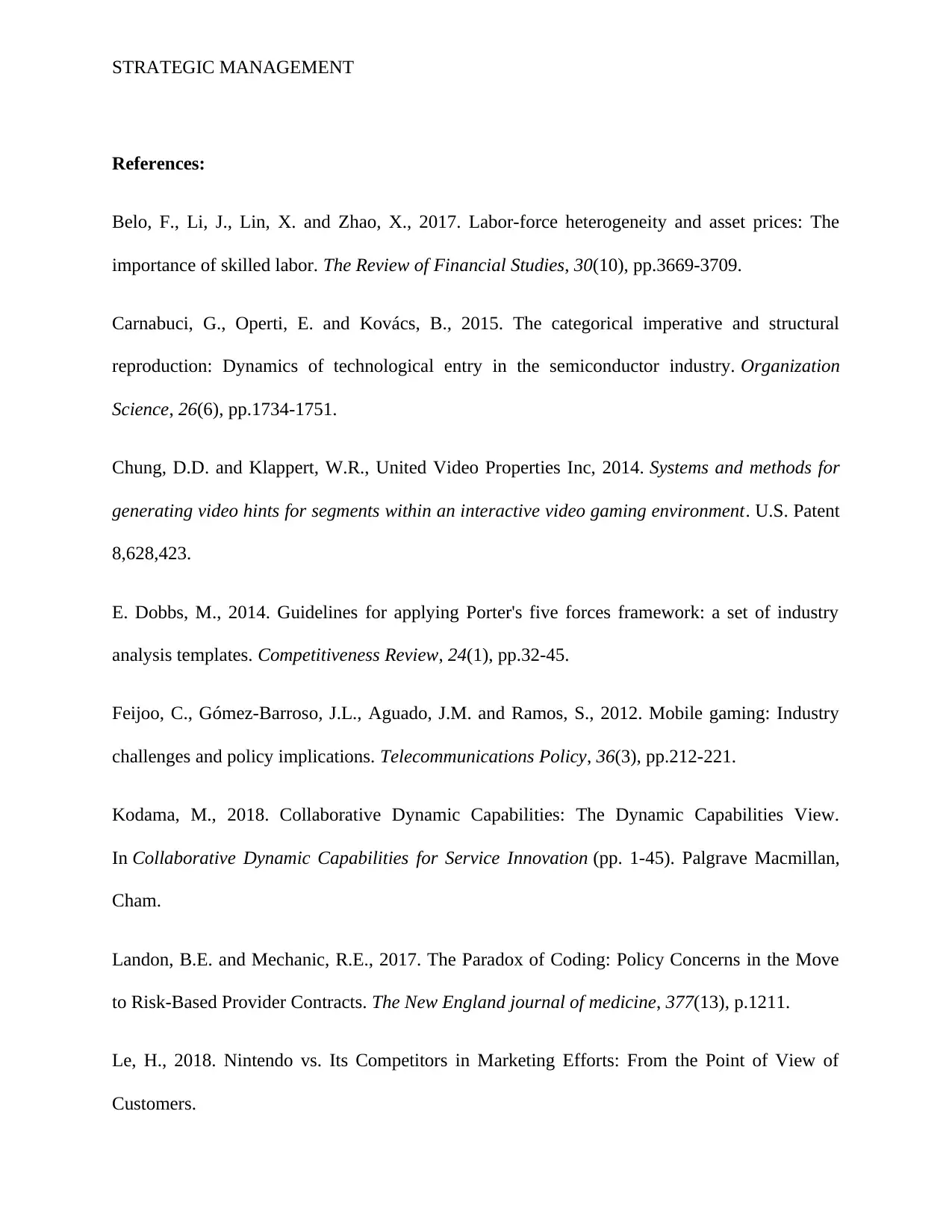
STRATEGIC MANAGEMENT
References:
Belo, F., Li, J., Lin, X. and Zhao, X., 2017. Labor-force heterogeneity and asset prices: The
importance of skilled labor. The Review of Financial Studies, 30(10), pp.3669-3709.
Carnabuci, G., Operti, E. and Kovács, B., 2015. The categorical imperative and structural
reproduction: Dynamics of technological entry in the semiconductor industry. Organization
Science, 26(6), pp.1734-1751.
Chung, D.D. and Klappert, W.R., United Video Properties Inc, 2014. Systems and methods for
generating video hints for segments within an interactive video gaming environment. U.S. Patent
8,628,423.
E. Dobbs, M., 2014. Guidelines for applying Porter's five forces framework: a set of industry
analysis templates. Competitiveness Review, 24(1), pp.32-45.
Feijoo, C., Gómez-Barroso, J.L., Aguado, J.M. and Ramos, S., 2012. Mobile gaming: Industry
challenges and policy implications. Telecommunications Policy, 36(3), pp.212-221.
Kodama, M., 2018. Collaborative Dynamic Capabilities: The Dynamic Capabilities View.
In Collaborative Dynamic Capabilities for Service Innovation (pp. 1-45). Palgrave Macmillan,
Cham.
Landon, B.E. and Mechanic, R.E., 2017. The Paradox of Coding: Policy Concerns in the Move
to Risk-Based Provider Contracts. The New England journal of medicine, 377(13), p.1211.
Le, H., 2018. Nintendo vs. Its Competitors in Marketing Efforts: From the Point of View of
Customers.
References:
Belo, F., Li, J., Lin, X. and Zhao, X., 2017. Labor-force heterogeneity and asset prices: The
importance of skilled labor. The Review of Financial Studies, 30(10), pp.3669-3709.
Carnabuci, G., Operti, E. and Kovács, B., 2015. The categorical imperative and structural
reproduction: Dynamics of technological entry in the semiconductor industry. Organization
Science, 26(6), pp.1734-1751.
Chung, D.D. and Klappert, W.R., United Video Properties Inc, 2014. Systems and methods for
generating video hints for segments within an interactive video gaming environment. U.S. Patent
8,628,423.
E. Dobbs, M., 2014. Guidelines for applying Porter's five forces framework: a set of industry
analysis templates. Competitiveness Review, 24(1), pp.32-45.
Feijoo, C., Gómez-Barroso, J.L., Aguado, J.M. and Ramos, S., 2012. Mobile gaming: Industry
challenges and policy implications. Telecommunications Policy, 36(3), pp.212-221.
Kodama, M., 2018. Collaborative Dynamic Capabilities: The Dynamic Capabilities View.
In Collaborative Dynamic Capabilities for Service Innovation (pp. 1-45). Palgrave Macmillan,
Cham.
Landon, B.E. and Mechanic, R.E., 2017. The Paradox of Coding: Policy Concerns in the Move
to Risk-Based Provider Contracts. The New England journal of medicine, 377(13), p.1211.
Le, H., 2018. Nintendo vs. Its Competitors in Marketing Efforts: From the Point of View of
Customers.
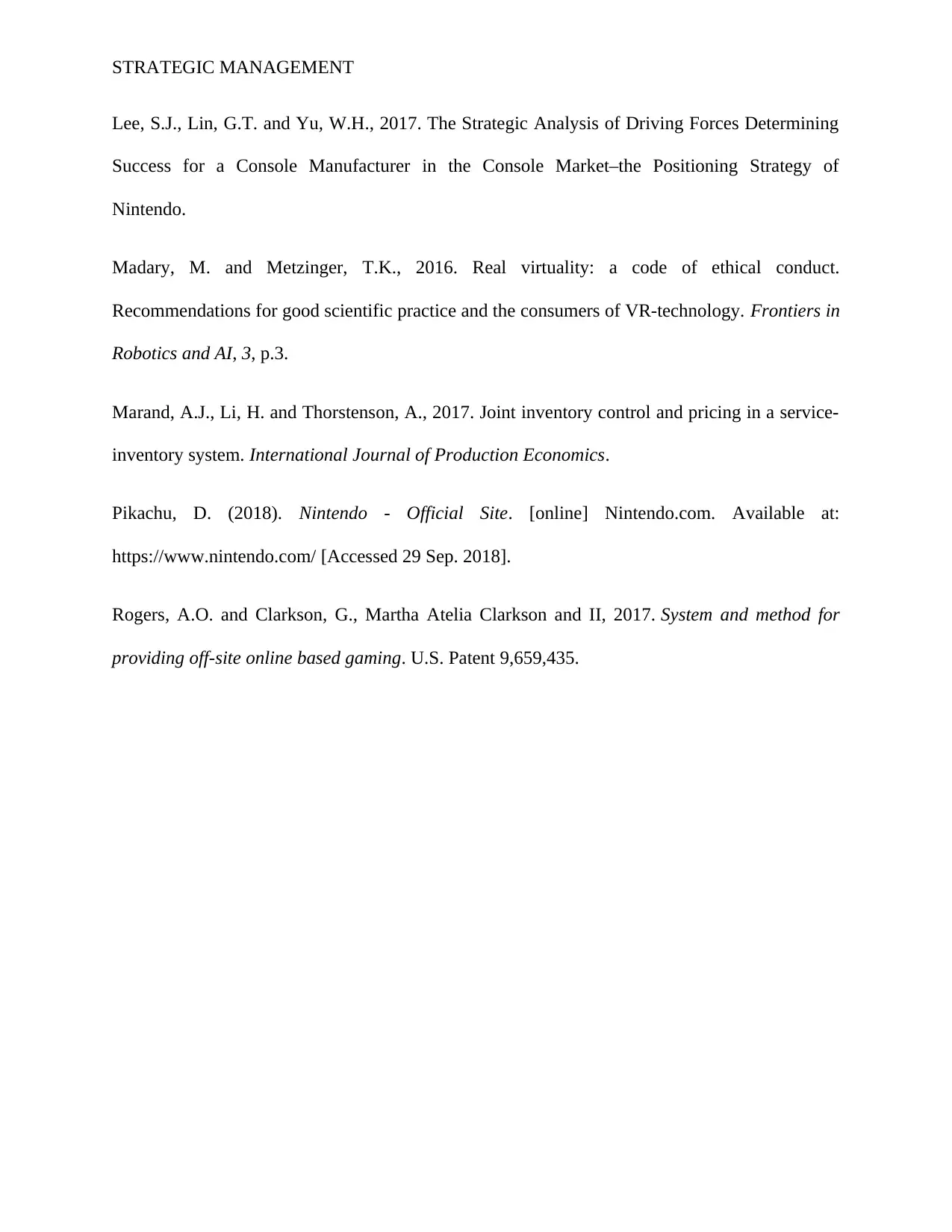
STRATEGIC MANAGEMENT
Lee, S.J., Lin, G.T. and Yu, W.H., 2017. The Strategic Analysis of Driving Forces Determining
Success for a Console Manufacturer in the Console Market–the Positioning Strategy of
Nintendo.
Madary, M. and Metzinger, T.K., 2016. Real virtuality: a code of ethical conduct.
Recommendations for good scientific practice and the consumers of VR-technology. Frontiers in
Robotics and AI, 3, p.3.
Marand, A.J., Li, H. and Thorstenson, A., 2017. Joint inventory control and pricing in a service-
inventory system. International Journal of Production Economics.
Pikachu, D. (2018). Nintendo - Official Site. [online] Nintendo.com. Available at:
https://www.nintendo.com/ [Accessed 29 Sep. 2018].
Rogers, A.O. and Clarkson, G., Martha Atelia Clarkson and II, 2017. System and method for
providing off-site online based gaming. U.S. Patent 9,659,435.
Lee, S.J., Lin, G.T. and Yu, W.H., 2017. The Strategic Analysis of Driving Forces Determining
Success for a Console Manufacturer in the Console Market–the Positioning Strategy of
Nintendo.
Madary, M. and Metzinger, T.K., 2016. Real virtuality: a code of ethical conduct.
Recommendations for good scientific practice and the consumers of VR-technology. Frontiers in
Robotics and AI, 3, p.3.
Marand, A.J., Li, H. and Thorstenson, A., 2017. Joint inventory control and pricing in a service-
inventory system. International Journal of Production Economics.
Pikachu, D. (2018). Nintendo - Official Site. [online] Nintendo.com. Available at:
https://www.nintendo.com/ [Accessed 29 Sep. 2018].
Rogers, A.O. and Clarkson, G., Martha Atelia Clarkson and II, 2017. System and method for
providing off-site online based gaming. U.S. Patent 9,659,435.
1 out of 19
Related Documents
Your All-in-One AI-Powered Toolkit for Academic Success.
+13062052269
info@desklib.com
Available 24*7 on WhatsApp / Email
![[object Object]](/_next/static/media/star-bottom.7253800d.svg)
Unlock your academic potential
© 2024 | Zucol Services PVT LTD | All rights reserved.





